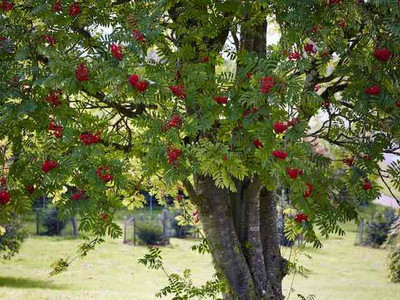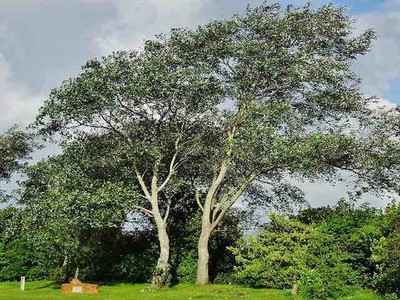About Bare Root Trees
Why Plant Bare Root Trees?
Everyone seems to be talking about trees these days and with good reason. They are one of the single most effective ways to take carbon out of the atmosphere and help slow global warming. Trees also give us many other benefits including soil conservation, flood prevention and habitat creation.
In general they are easy to plant, don't require any maintenance and will be a growing asset for generations. Wherever there is available space we really should be planting more of them.

Of course there is no such thing as a 'bad' tree but there can be problems with trees planted in the wrong place that don't suit the local environment. There is growing opposition to Sitka spruce plantations which may be a good commercial 'crop' but have negative effects on the area they are planted in.
In general non-native conifers are poor habitats for wildlife and (in the case of large conifers) can be difficult to live with for local people, as they block out light and are a radical change to the landscape.

If you left a patch of land anywhere in the UK and Ireland alone for enough time it would naturally return to broadleaf woodland. Apart from some exceptions like the Scots pine, our wildlife has adapted to suit broadleaf trees which have more variation in shape and cover and therefore more options to make a home.
There are ambitious tree planting plans in both the UK and Ireland to help balance the national carbon footprint, but we need to make sure commercial and native forests are planted in balance. Conifer plantations may have their place as a cash crop, but as gardeners we should probably champion native species and more varied woodland.

Pioneer Species
Naturally it is a hard sell to convince a farmer to turn over good, productive land to trees. It is therefore marginal land that is more likely to be earmarked for forestry. Unfortunately large broad leaf trees like Oak or Beech need deep, fertile soil to thrive so will not be good candidates for poor quality land.
This is where the pioneer species come in. Trees like Alder and Birch were the first to colonise after the Ice Age and are experts at growing on less than ideal terrain. Pioneer species are fast growing and can quickly cover bare land and begin the process of re-generation.

The Alder is particularly impressive as it can convert atmospheric nitrogen into ammonia which it can use for growth, but also helps to enrich the surrounding soil when the leaves fall in Autumn. Alder trees 'fix' nitrogen in the same way as legumes (peas and beans) by providing homes for nitrogen fixing bacteria in nodules (pictured above) on their roots. While legumes partner with rhizobia for this job, non-legumes like Alder use the same method but a different group of bacteria from the genus 'Frankia'.
Alder is also ideally suited to wet soil or acid conditions and will be fast growing even with severe exposure to wind.

The Rowan or Mountain Ash is a longer lived pioneer tree (it can live up to 400 years). It is very hardy and will grow at the highest altitude of any other tree. It is a very good garden tree and can easily be kept at a manageable size without losing it's shape. The Mountain Ash is a pretty tree with feather-like leaves, complimented by red berries in the Autumn.
If you have apples the Rowan is a good companion tree as birds will eat the red fruit in preference to apples which ripen at the same time. It is probably also worth noting that the mountain ash (Sorbus) is not related to the common ash (Fraxinus) and does not suffer from the ash die back disease that is killing so many European trees.

Pioneer species pave the way for larger, less hardy trees by improving and stabilising soil - and by providing shelter while other species get established. They are relatively short-lived in tree terms and usually survive for 60 - 140 years, but do some incredible work while they are there. They are also beautiful trees in their own right and provide some of the best wildlife habitats.
Our range of bare root trees
I will come back to trees another day as there is a lot to talk about but for now I want to draw attention to our range of bare root tree saplings. We have chosen to supply smaller 60-90cm trees for a number of reasons but I guess the main ones from your point of view is that they are more cost effective but will also produce a much better tree.

As you can see in the image above, tree roots don't mirror the shape of the canopy below ground, but spread out much further than the tree in a wide mat close to the surface. This makes sense as there is more air and nutrients in the top layers of soil. The surface roots form a fine web and are the feeding roots, while the deep tap roots below the tree are growing down in search of water.
The problem with replanting larger trees is no matter how much of a root ball you bring with it you will have lost over 50% of the original root mass. Smaller transplants have a more balanced root/stem ratio so will establish quicker and produce a healthier, more stable tree.

Staking Trees
One of the reasons trees need to be staked when planted is that their canopy is out of balance with their root systems. Staking is almost inevitable with a large transplant, but is not necessary with trees below 120cm. A tree needs an amount of movement when young, as this strengthens up the trunk and also gives it its taper. Trunk movement also stimulates root growth, so although staked trees might grow taller quicker than unstaked trees, their trunks are weaker and their root systems are less developed.

Choose Your Own 6 Pack Bare Root Trees
During the autumn season we supply our trees in packs of six using our 'choose your own' system. We have set up the product page so that you can view up to 15 varieties and choose any mix of trees provided; the total number is 6.
There is also information about each tree, including height and spread which can be accessed by clicking the blue button beside each icon.
If you need help either choosing or planting a tree, email: andrew@quickcrop.ie.





